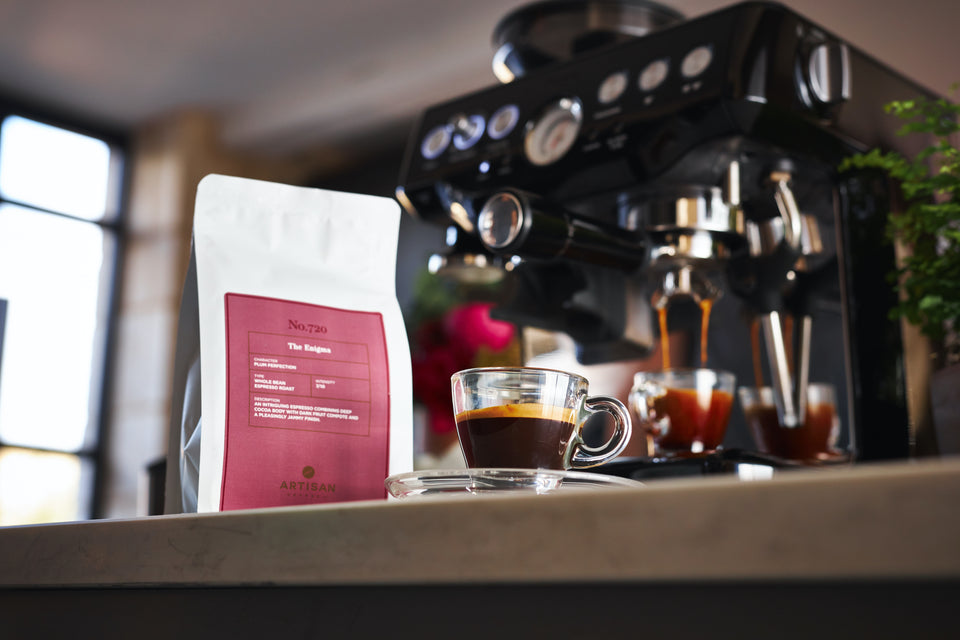Coffee cupping is the art of coffee tasting. Industry professionals use this method to rate the beans’ complex flavours and characteristics.
In this coffee cupping guide, you’ll learn exactly what cupping is and how to taste coffee like a pro. Whether you're a complete novice or a coffee aficionado, here’s our step-by-step guide to coffee cupping.
What is Coffee Cupping & Tasting?
Coffee has complex and diverse characteristics. Everything from place of origin, to crop and roasting will influence the flavours and textures of the bean. Cupping involves tasting the coffee to evaluate the characteristics and the quality of the beans. This technique scores coffee bean batches on key aspects such as acidity, sweetness, mouthfeel, and aftertaste.
Cupping is not just a quality control method. It allows you to compare and contrast different coffees so you can spot differences, achieve the best brewing method, and find quality blends.
Coffee cupping is a method which is used by producers and buyers around the world. It can also help coffee drinkers gain an understanding of coffee’s complexities and different characteristics.
To do a successful cupping, you should always use the same method for every coffee you’re tasting. Any deviation can affect the results and you won’t be able to get a clear comparison.

How to Taste Coffee like a Pro
Coffee cupping is easy to do at home with the right equipment. Before you start, make sure you have a selection of bowls that can hold 200-260ml of water, a set of scales, a coffee grinder, a set of spoons and a timer.
Choose a range of coffee beans from different regions and roasts to get a good comparison. Once you have everything ready, follow the step-by-step guide below to learn how to taste coffee like a pro:
Step 1: Measure out your coffee. The recommended ratio is 8.25 grams per 125ml of water. So, if your bowl holds 200ml then use 11 grams of coffee. Add an extra 2 grams of each roast to decontaminate the grinder in step 2.
Step 2: Grind out the first 2 grams of the coffee to prep the grinder. Then grind the remaining 11 grams and tip them into their designated cupping bowl. Follow this step for each roast, starting with the 2 grams first to ensure no other coffee impedes the flavour. Grind to a coarse consistency so it looks like sea salt.
Step 3: Smell the dry coffee beans. Strike the cupping bowl firmly on the table to release the aromas and then bring it up to your nose. Start taking notes of your initial experiences with each roast. See what characteristics you can pick up depending on the coffee’s origin. Coffees from African countries tend to be fruity and floral, whereas coffees from South America may have more creamy, chocolatey aromas.
Step 4: Set your timer to 4 minutes and add the water. The water temperature should be between 94-95 degrees Celsius, so just off the boil. Ideally, the water should also be filtered. The purer the better. Water quality and the chemicals within it can affect the flavour of the coffee.
Step 5: Once the timer goes, it’s time to ‘break the crust’. Take two small spoons and angle the first one away from you to break the bubbly film on top of the coffee and release the aroma. Stir the bowl gently to allow some of the grinds to sink to the bottom. Any floating grinds that remain should be scooped away.
Step 6: The key to tasting coffee properly is to slurp. The noisier the better! Take a deep spoonful of your coffee infusion, pour it into the other spoon and bring it up to your mouth. Give it a powerful suck so that the coffee coats the roof of your mouth and the back of your tongue. Spray the back of your mouth with the coffee. This might sound intense, but it’s important. Slurping your coffee like this stimulates your sense of smell as well as taste and, as such, the depth of the bean’s flavour can be fully identified and appreciated.
Step 7: Pretend to chew the coffee as it will give you more time to notice the different aromas. You can also leave the coffee to cool for a few minutes and taste it again. More acidity is released as coffee cools which changes the flavour. Swallow or spit your mouthful. In a professional coffee cupping, spitting out is a must as hundreds of cups are tasted. Remember to also clean the spoons between each cup.
Step 8: Rate each infusion as you taste it. Look out for texture and acidity. Take note of the flavours and aftertaste. Can you taste chocolate or fruit? Is it light or dark? Is the acidity mild or sharp? As the coffee cools, consider the change in body and finish. Is it thick or thin? Is the finish long and lingering or quick and clean? There’s no right or wrong answer here, just opinions. Jot everything down using a coffee cupping chart.

Coffee Cupping & Tasting FAQs
What is a coffee cupping spoon?
A coffee cupping spoon is flat and wide like a soup spoon. If you don’t have one, use a teaspoon.
What are the four main steps of coffee tasting?
The four key steps of tasting coffee are smell, slurp, locate and describe.
First, you smell the coffee. Identify what aromas you can pick up when the coffee is dry and notice how they become more potent when wet.
Next, slurp. Spray the coffee around your mouth. Let it spread to the roof right to the back and across your tongue.
Now, locate. Observe how the coffee feels. Is it thick or thin? Is it heavy or light? Notice where the flavours are coming from on your palette.
Lastly, describe. What words describe your tasting experience? What aromas and flavours can you detect? Does the coffee taste sharp or smooth? How does the coffee feel in your mouth and what do you notice about the aftertaste?


Are you sure?
By not selecting to receive marketing communications you'll lose most of the benefits associated with the QClub
Oooops, that's annoying.
Unfortunately one off product can't be purchased at the same time as subscription or pre-order purchases.
Please proceed using separate transactions.
Unfortunately subscriptions can't be purchased at the same time as one-off purchases.
Please proceed using separate transactions.
Unfortunately, pre-order products have to be purchased on their own.
Please proceed using separate transactions.
